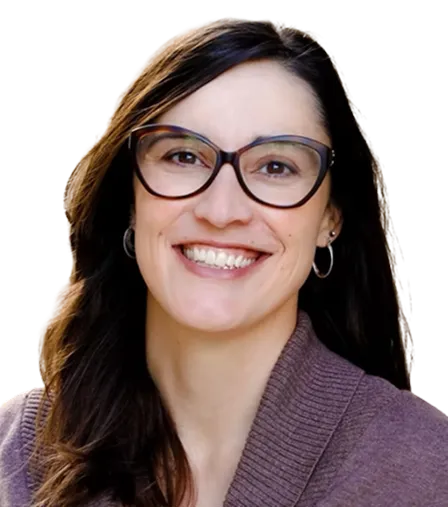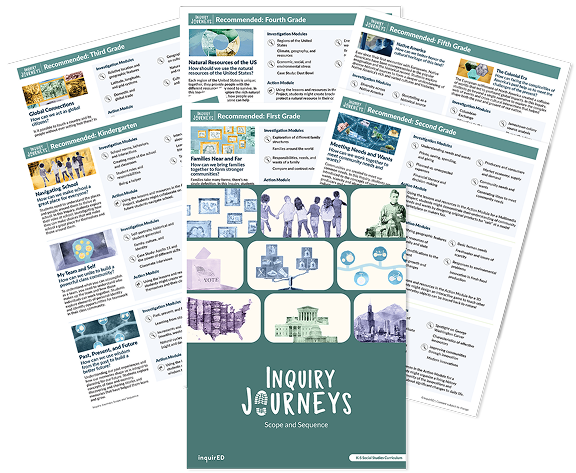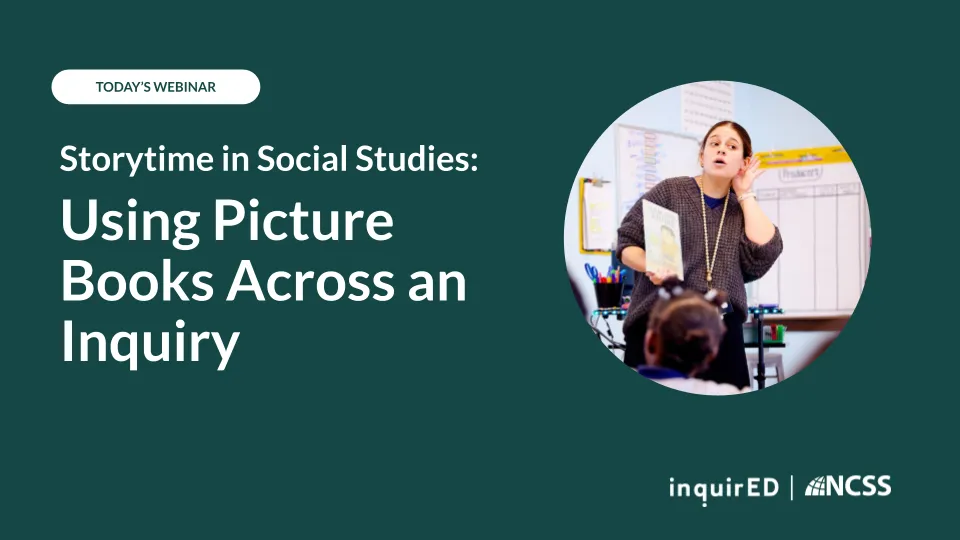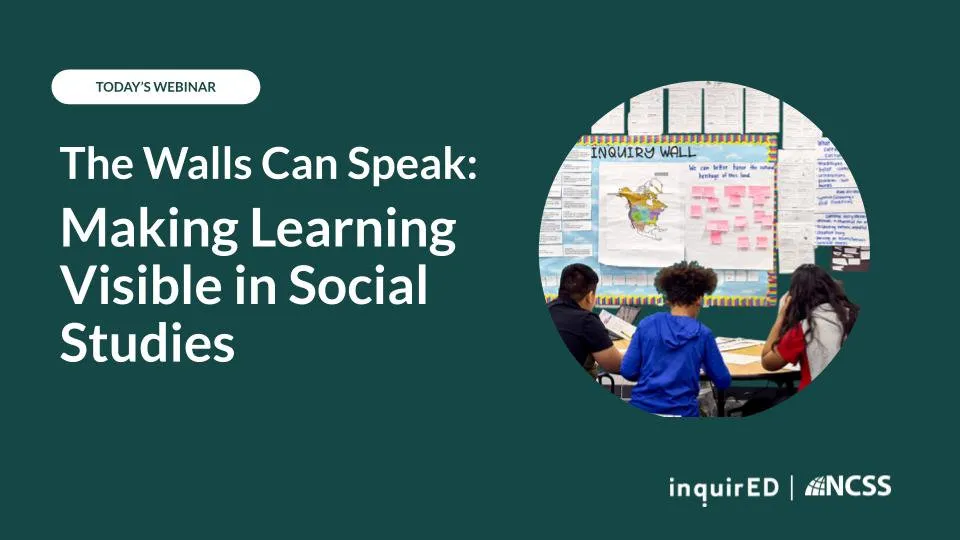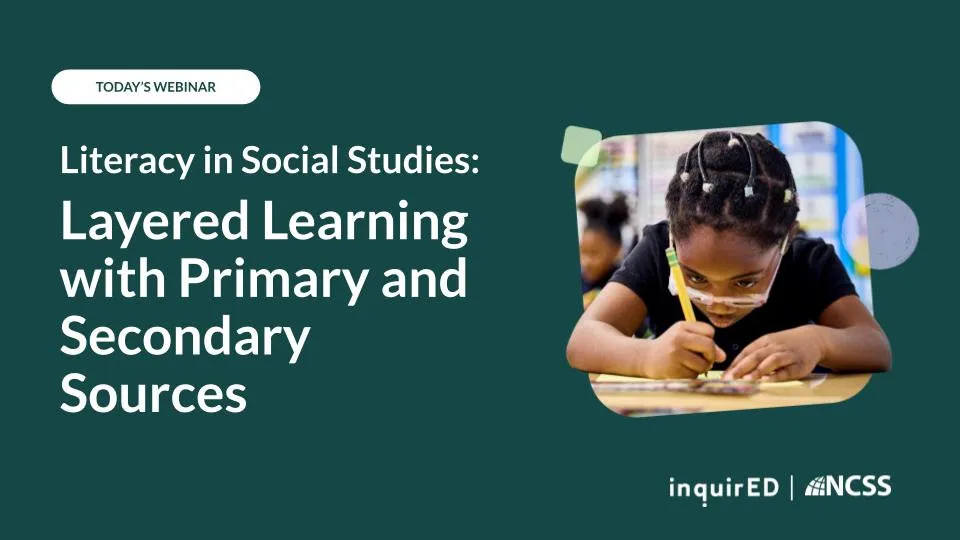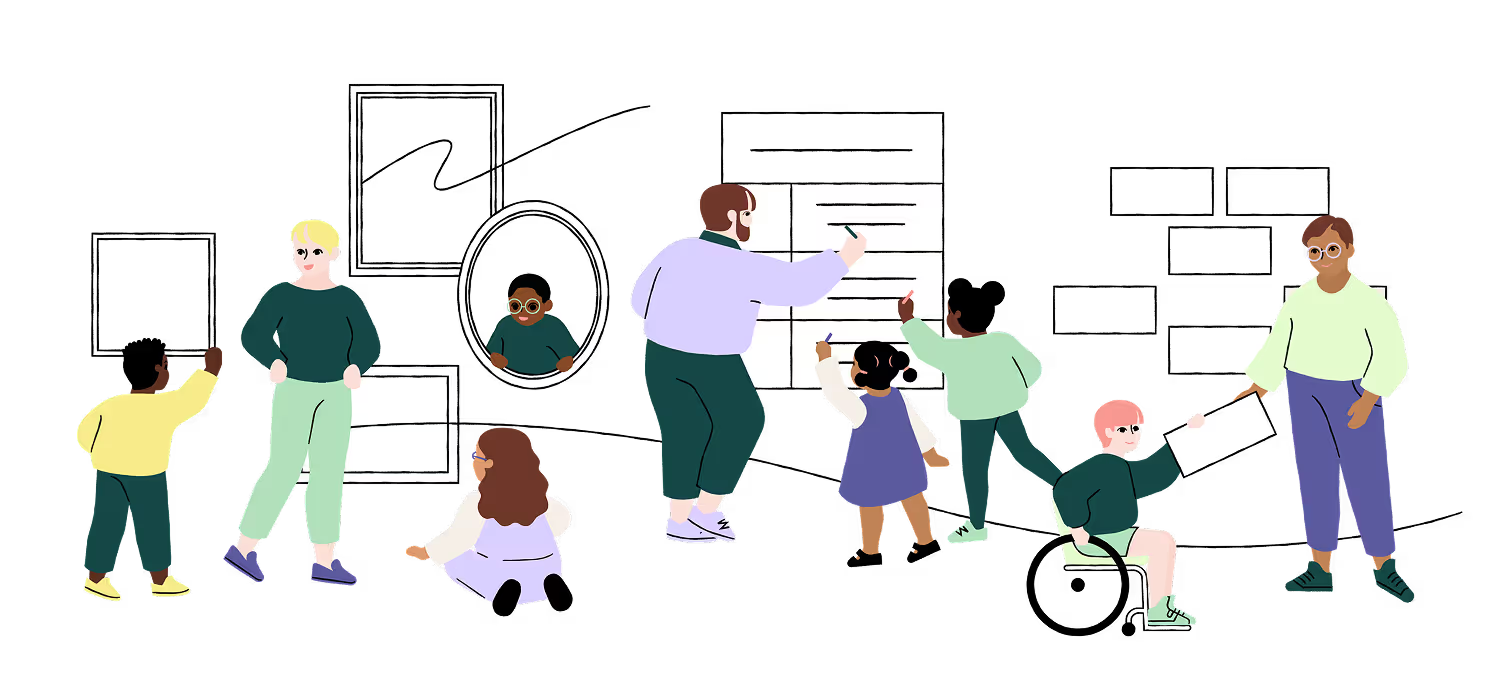High-Quality Instructional Materials in Social Studies
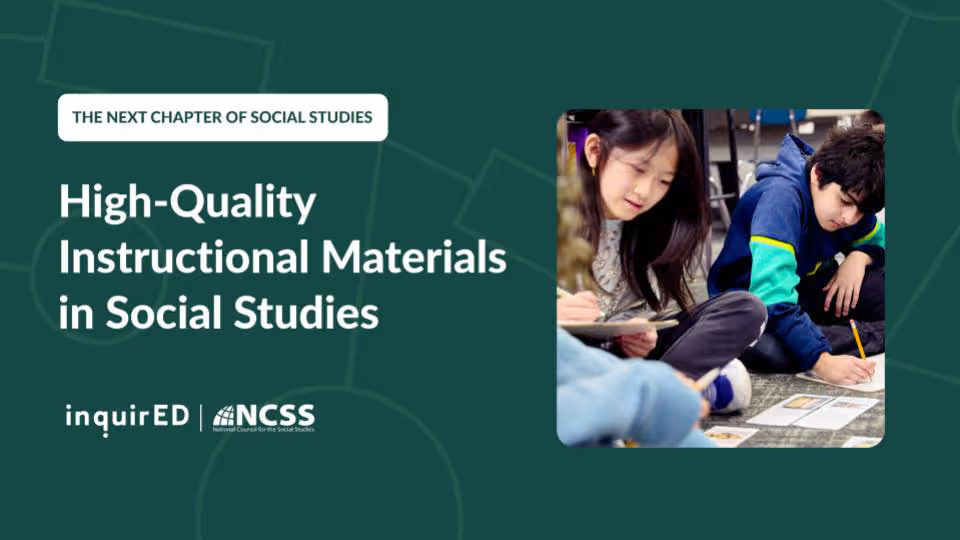
NOTE: There is no recording for this webinar.
High-Quality Instructional Materials in Social Studies

What does “high quality” really mean in social studies curriculum? How can materials balance inquiry, explicit instruction, and teacher support? In our recent webinar, inquirED’s Shanti Elangovan and Elisabeth Ventling Simon explored the newly revised Social Studies Curriculum Review Guide—a practical, research-aligned tool designed to help educators evaluate and strengthen instructional materials across five essential domains.
Key Takeaways
- High-quality instructional materials are comprehensive by design. They integrate inquiry, explicit instruction, and teacher supports to build deep, transferable knowledge.
- Inquiry and knowledge building work together: Effective inquiry design layers knowledge and skills through engagement with students’ existing funds of knowledge, explicit instruction, and authentic application of learning.
- Transfer is essential to lasting learning. Students deepen understanding when they apply concepts and skills in new and meaningful contexts, both inside and beyond the classroom.
- Support for teachers are central to implementation of HQIM: The revised Curriculum Review Guide highlights how strong materials and teacher expertise work hand-in-hand to create equitable, engaging social studies instruction.
What Makes Instructional Materials “High Quality”
The U.S. Department of Education defines High-Quality Instructional Materials (HQIM) as:
“Standards-aligned, content-rich instructional tools that provide a coherent scope and sequence for grade-level academic content. HQIM provide a full suite of resources for teachers, students, and families, including lesson plans, instructional units, and embedded formative assessments. HQIM utilize evidence-based instructional strategies and provide implementation supports for educators to ensure the learning needs of all students are met.”
That is a high bar, and as Shanti Elangovan, CEO and Founder of inquirED, reminded webinar participants, HQIM are more than a new label for curriculum. “Curriculum, as we used to think of it, was the textbook and a workbook, maybe a teacher guide. But HQIM is something much more—coherent, evidence-based, and designed to support teachers in meeting the learning needs of all students.”
The promise of HQIM, she noted, lies in their impact. “Imagine if we could make every average teacher that highly skilled teacher. That’s what the research tells us high-quality instructional materials have the potential to do.”
When inquirED first published the Social Studies Curriculum Review Guide in 2020, it was designed to fill a gap: a clear definition of what quality looks like in social studies materials. “We saw this gap in the space,” said Shanti. “ELA, math, and science had rubrics and structures for defining high quality, but social studies didn’t.” Since then, the Guide has been downloaded more than 10,000 times and adopted by districts and states across the country. This year, inquirED released a revised edition shaped by new research, classroom insights, and feedback from the field.
Touring the Revised Review Guide
The updated Curriculum Review Guide centers on five essential domains that define high-quality social studies materials:
- Depth of Knowledge and Skills
- Structured and Coherent Inquiry Design
- Balanced Representation and Multiple Perspectives
- Literacy Development
- Usability and Educator Support
Each domain includes detailed indicators to help educators identify strengths and opportunities for growth in curriculum materials. “What good are high-quality instructional materials if teachers don’t use them?” said Elisabeth Ventling Simon, inquirED’s Chief Academic Officer. “We want materials that are clear, coherent, and designed to support both teaching and learning.” Elisabeth described how the revision process deepened each domain. “We’ve learned so much since 2020—from educators using the Guide and from our own work implementing Inquiry Journeys. This revision reflects all of that learning.”
Depth of Knowledge and Skills
The first domain, Depth of Knowledge and Skills, looks at how curriculum supports students in building both disciplinary knowledge and the skills of a social scientist over time. As Elisabeth Ventling Simon explained, “We’re talking about what students know and can do across all four disciplines of social studies—factual understanding, conceptual understanding, and disciplinary thinking and skill.”
Elisabeth shared an example from geography, focusing on human-environment interaction and spatial reasoning. Students begin in the early grades by locating themselves in space, using positional words and simple maps to describe their immediate world. As they move through the grades, they expand that perspective, learning to use geographic tools and vocabulary to analyze relationships between people and environments. By the upper grades, students apply these tools to investigate complex spatial patterns, map change over time, and explore the connections between geography, culture, and history.
This kind of sequencing and spiraling, where concepts and skills build purposefully from one grade to the next, is a defining feature of high-quality instructional materials. It ensures that learning does not happen in isolation but grows cumulatively, preparing students to apply disciplinary thinking in new and increasingly complex contexts.
Structured and Coherent Inquiry Design
Designing for Knowldge Building
Building on this foundation, the second domain, Structured and Coherent Inquiry Design, explores how curriculum organizes that knowledge and skill development through purposeful inquiry. As Shanti Elangovan explained, inquiry and knowledge building are not competing ideas but deeply connected. “We started to see this kind of false dichotomy between inquiry on one side and knowledge building on the other,” she said. “Inquiry is a vessel for building knowledge.”
"We started to see this kind of false dichotomy between inquiry on one side and knowledge building on the other, but Inquiry is a vessel for building knowledge."
Effective inquiry design, she emphasized, combines engagement, explicit instruction, and authentic application so that students build understanding step by step. “Students don’t learn things about geography or historical thinking through osmosis,” she said. “There is a lot of explicit instruction that has to occur in order for students to gain that knowledge.”
Shanti also underscored that this process begins with students’ existing knowledge and lived experiences. “Students come in with funds of knowledge,” she said. “They’re not empty vessels to be filled up. We have to tap into what they already know and connect new learning to that.” At the same time, she pointed out that when inquiry relies only on student-led exploration without building shared background knowledge, “it can really advantage highly resourced students.” High-quality materials must therefore ensure that every student, regardless of background, has access to the knowledge they need to participate meaningfully in inquiry.
Designing for Transfer and Application
The third key concept that emerged in the discussion was transfer, which Elisabeth described as central to both the design and the purpose of inquiry-based learning. “When I’m thinking about transfer,” she explained, “I’m thinking about students taking what they’ve learned—the knowledge and skills that they’ve built—and applying it in a new and meaningful context.”
“Transfer isn’t an add-on that could happen; it’s an essential part of the design of the inquiry.”
Transfer, she noted, is what makes learning stick. “It’s one of the things that makes learning durable,” Elisabeth said. “When students apply their understanding to interpret a new problem, to make a decision together, to act in the world around them—that’s what’s going to make it meaningful to them.” She connected this directly to the final dimension of the C3 Framework, Taking Informed Action. “Transfer isn’t an add-on that could happen; it’s an essential part of the design of the inquiry.”
Elisabeth offered a classroom example from a fourth-grade unit on the Dust Bowl. Students explore how drought and farming practices led to widespread ecological and economic impact. Later, when they encounter a new context—such as learning about algae blooms caused by agricultural runoff—they can apply the same conceptual understanding about how human activity changes the land and how those changes affect communities and economies. “The specific names and dates of the Dust Bowl are not going to transfer,” she explained. “It’s the conceptual understanding that does.”
Transfer can also take the form of local action. “Maybe students are noticing how behaviors in their own context are impacting the land around them,” Elisabeth said. “They can use what they’ve learned to inform others, to influence thinking, or to take thoughtful action.”
Balanced Representation and Multiple Perspectives
The third domain, Balanced Representation and Multiple Perspectives, focuses on how curriculum helps students navigate complex topics and think critically about perspective. Elisabeth explained, “We’re really thinking about the responsibility that curriculum has, not just the teacher, to ensure that students get an accurate, nuanced picture of the past, as well as contemporary issues.” She emphasized that materials should neither avoid complexity nor oversimplify. “We don’t want curriculum to avoid complex topics,” she said, “but we also don’t want curriculum to present oversimplified narratives or to insert ideological positions.”
Shanti noted how challenging this work can be. “We can provide diverse sources,” she said, “but we also have to think about how those sources fit together. It’s incredibly difficult work.” She added that while curriculum can model respectful engagement with difference, teachers “bring the human, relational part of it:, the contextual layer.”
Literacy Development
The fourth domain, Literacy Development, highlights how social studies and literacy are deeply connected. Elisabeth explained that rigorous social studies requires content literacy and disciplinary literacy. “We can’t just have primary and secondary sources and give them to our students,” she said. “They need literacy skills to understand what they’re reading or hearing.”
She also emphasized that high-quality materials must support communication and discourse. “Discourse takes skill,” Elisabeth said. “It’s not just about providing opportunities for discussion. We need to build those speaking and listening skills so that students can communicate clearly and engage in civil discourse.”
Usability and Educator Support
The final domain, Usability and Educator Support, turns attention to teachers and implementation.
“HQIMs are not a magic bullet. They're a really important piece of the puzzle. But teachers bring the expertise, the relationships, and the context that make it come to life.”
This domain underscores the need for clear lessons, predictable structures, and actionable guidance. Teachers should have “embedded supports that let them focus on good teaching,” Elisabeth said, along with professional learning that helps them “deepen their understanding of practice as they’re using curriculum.”
Shanti closed by reminding participants that curriculum is only one part of the equation. “HQIMs are not a magic bullet,” she said. “They're a really important piece of the puzzle. But teachers bring the expertise, the relationships, and the context that make it come to life.”
Looking Ahead
The revised Social Studies Curriculum Review Guide reflects both the progress of the field and the practical realities of classrooms. Across its five domains, the guide defines what it takes for materials to truly support deep learning: coherent design, inclusive representation, strong literacy integration, and meaningful support for teachers. As the conversation made clear, high-quality instructional materials are not just about content. They are about connection—between inquiry and knowledge building, between students’ lived experiences and new ideas, and between curriculum and the teachers who bring it to life.
To explore how these principles come to life in schools and districts, join us for the next webinar in the series, Implementing Elementary Social Studies Across a District, where we’ll focus on supporting teachers, strengthening systems, and sustaining high-quality instruction.
Resources
- inquirED's Curriculum Review Guide PDF
- inquirED's Curriculum Review Guide Google Doc
- The link above will ask you to make a copy of the existing google doc. You will need to login to your own google drive to do this.
Keep reading
See more of this series
Start your journey
Inquiry Journeys, inquirED's K-5 social studies curriculum, engages students in inquiry-based learning, strengthens literacy skills, and supports teachers every step of the way.
inquirED was founded by teachers with the mission of bringing inquiry-based social studies to every classroom. Inquiry Journeys, inquirED’s elementary social studies curriculum, is used in schools and districts across the country to help students develop deep social studies content knowledge and build the inquiry skills that are essential for a thriving democracy.

